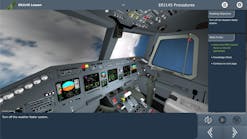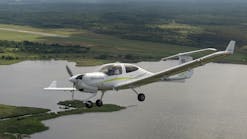Getting Your Inspection Authorization
Some tips to help you along your way to an IA
By Joe Escobar
Well it is that time of year again. All over the country, mechanics with Inspection Authorization (IA) are filling out their FAA Form 8610-1 and giving it to their local FSDO in order to stay current for yet another year. Have you ever wondered what it takes to be an IA? Are you looking for some tips and pointers on studying for the IA exam? This article will provide some tips for getting your IA.
Why get your IA?
Each mechanic has his or her own reason for obtaining an IA. It could be to make extra money performing annual inspections. It could be for promotion opportunities within their company. It could even be a status symbol, a badge of honor if you will.
For many, a sense of professionalism leads them to obtain their IA. "For me, it boiled down to being the best mechanic I could be," says Howard Sidlecki, an FBO owner who has had his IA for 30 years shares. "It was the next logical step for me in my career."
Jim Freeman, a repair station owner who has had his IA for 10 years, states that the main reason he got his IA was because the company he was working for at the time gave him the opportunity to get it. "The company I worked for encouraged its mechanics to get their IA. They even paid for us to take a study class. I took advantage of that opportunity and got my IA. It has helped open up many opportunities in my career."
"I got my A&P to become more well-rounded in my aviation career," says Peter Bradsell, a quality assurance manager who recently got his IA. A certificated pilot for many years, Bradsell got his A&P five years ago. "After having my A&P for three years, it seemed that getting my IA was the next logical progression in my education as a mechanic."
Minimum requirements
There are minimum requirements to become an IA. These requirements can
be found in FAR 65.91. To be eligible for an inspection authorization, an applicant must:
- Hold a currently effective mechanic certificate with both an airframe rating and a powerplant rating, each of which is currently effective and has been in effect for a total of at least 3 years;
- Have been actively engaged, for at least the last 2-year period before the date he applies, in maintaining aircraft certificated and maintained in accordance with the FARs;
- Have a fixed base of operations at which he may be located in person or by telephone during a normal working week but it need not be the place where he will exercise his inspection authority;
- Have available to him the equipment, facilities, and inspection data necessary to properly inspect airframes, powerplants, propellers, or any related part or appliance; and
- Pass a written test on his ability to inspect according to safety standards for returning aircraft to service after major repairs and major alterations and annual and progressive inspections performed under Part 43 of the FARs.
Studying for the test
Once you know you want to get your IA, you need to spend some time preparing for the test. FAA-G-8082-11 (http://av-info.faa.gov/data/knowledgetestguide/faa-g-8082-11.pdf) Inspection Authorization Knowledge Test Guide gives some good pointers on studying for the test. Here are some of those tips:
- Be familiar with the parts of Title 14 Code of Federal Regulations (14 CFR) as listed in appendix 2.
- Study 14 CFR parts 91 and 135 aircraft maintenance and inspection requirements.
- Be familiar with aircraft type certificate data sheets and specifications. This should include the differences and history of these documents. Applicant should know how revisions are noted.
- Study 14 CFR part 43, appendixes A, B, and D for detailed information regarding major repairs, major alterations, and annual inspections.
- Learn to use the graphs and tables in AC 43.13-1B (or most current revision) Acceptable Methods, Techniques and Practices - Aircraft Inspection and Repair; and AC 43.13-2A, (or most current revision) Acceptable Methods, Techniques, and Practices - Aircraft Alterations.
- Be familiar with airworthiness directives for small aircraft and rotorcraft. This should include knowledge of the rule, 14 CFR part 39.
- Be familiar with the completion of FAA Form 337 (Major Repair and Alteration - Airframe, Powerplant, Propeller, or Appliance). Guidance in this area is provided in AC 43.9-1E, Instructions for Completion of FAA Form 337, Major Repair and Alteration (Airframe, Powerplant, Propeller, or Appliance).
- Know the requirements for maintenance and inspection record entries for 14 CFR parts 43, and 91. Guidance in this area is provided in AC 43.9B, Maintenance Records; also AC 39-7B, Airworthiness Directives.
- Be familiar with minimum equipment list for general aviation aircraft. Guidance in this area is provided in AC 91-67, Minimum Equipment Requirements for General Aviation Operations under FAR Part 91.
- Be familiar with all aspects of weight and balance computations. Applicant must be able to:
a. Calculate basic empty weight and center of gravity in both inches and percent of mean aerodynamic chord (MAC).
b. Conduct adverse loading checks for extreme forward and rearward CG positions.
Applicants should practice making changes to an aircraft weight and balance report by simulating installing or removing equipment and then computing the forward, aft, and empty weight center of gravity (CG). Guidance in this area is provided in AC 65-9, Airframe and Powerplant Mechanics General Handbook and AC 91-23, Pilot's Weight and Balance Handbook. Also, many commercial publications are available on this subject. NOTE: You should use the most current versions of all referenced documents.
As far as the method of studying, you can either choose to study on your own, purchase one of the study guides available to help guide your studying, or attend an IA study course. The IAs that I talked to used varying study methods. "I used a study guide" shares Cates. "It really helped out. It would give pointers on researching TCs and ADs and looking up information in AC 43.13 1B. The book would also give different scenarios that would help develop research skills." Bradsell also used a study book. "I purchased the ATP book and started studying a few months before I was eligible to get my IA," he says. "I was able to walk my way through different problems. It helped increase familiarity with looking up TCs, ADs, filling out 337s, and performing weight and balance calculations."
Sidlecki just relied on self-study. "I was fortunate to work with an old-timer," he says. "The guy was a great source of knowledge, and he mentored me. I learned a lot from him."
Freeman attended an IA course. "I attended a 3-day IA study course. It was a really good program. I became familiar looking up data and everything necessary to take the test. It is not like an A&P cram course where they have you memorize answers," he says. "You really get the opportunity to learn skills that help in research and problem-solving."
Time to test
Once you are ready to take the test, contact your local FSDO to meet with
an Aviation Safety Inspector (ASI) (airworthiness) to determine eligibility before you actually register for the test. You will need to present a filled out FAA Form 8610-1, Mechanic's Application for Inspection Authorization and provide proof of identification. During the meeting, the ASI will interview you in order to verify that you meet the requirements for the authorization. You will also be asked to provide proof of publications and technical data required to be kept current in accordance with 14 CFR part 43, section 43.13. Once you have demonstrated your qualifications to the inspector, he will give you the OK to test and provide you the names and locations of computer testing facilities that administer the test in the area.
Next, you should register for the test. Most testing facilities require a reservation to test, so be sure to call ahead of time. Keep in mind, many FAA Inspectors who give you an OK to test do so with a time limit (good for 90 days for example). If you don't want to go through the whole process over again, be sure to take the test within the required time window.
As far as the actual test goes, it is a 50 question, multiple-choice test. The minimum passing score is 70. All necessary reference materials will be provided by the testing facility. Gone are the days when you would have to lug in your microfiche reader and complete library.
There is a three-hour time limit to the test. This should prove to be more than sufficient time if you are well prepared. When taking the test, you have the options to either answer the question, skip the question, or answer and mark a question. Don't be afraid to skip a question. You can go back to questions at any time during the test. In fact, it can be a good idea to skip over a question and mark it if it is taking too long to find the answer. Better to come back to it later than to spend too much time on it and run out of time at the end. The ability to mark a question can also be a valuable tool. For example, you can choose to mark all questions you answered that you feel may not be right as well as those you choose to skip. At the end of your first run through the test, if you have 10 marked questions, you know you have at least an 80 percent score. You can then go back and concentrate on the ones you marked to increase the score.
Upon completion of the test, you will receive your Airman Test Report with the testing center's embossed seal on it which reflects your score. Do not lose this report. If you pass the test, you need to present this report at your local FSDO to receive your IA. It can be a good idea to return to the original ASI who interviewed you to take your test if possible, but any ASI can complete the authorization process. The ASI will review your application and discuss any questions you have. When the ASI is satisfied that all requirements have been met, he will issue the IA certificate.
If you fail the test, you may not apply for re-testing until 90 days after the date that you failed the test. Attempting to retest before the 90-day period is over could result in revocation of any airman certificates you hold. You will need to present your Airman Test Report to the test proctor when you are ready to retest after the 90-day waiting period.
These have been a few tips on getting your IA. You can read FAA-G-8082-11 (http://av-info.faa.gov/data/knowledgetestguide/faa-g-8082-11.pdf) Inspection Authorization Knowledge Test Guide for additional testing tips as well as practice questions. Be sure to contact your local FSDO if you have any questions on getting your IA. AMT





